United States
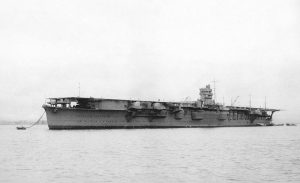 The Japanese had a tendency to be sneaky about their weapons of warfare, and their attack plans, as we know from Pearl Harbor. One such well kept secret was the Hiryu…which means Flying Dragon. The ship was a modified Soryu design that was built exclusively for the Imperial Japanese Navy. The Soryu, which means Blue Dragon, was built first, and because of the heavy modifications, the Hiryu was almost considered to be a separate class of ship. Hiryu had a displacement of 17,600 tons, length of 746 feet 1 inch, beam of 73 feet 2 inches, draft of 25 feet 7 inches and a speed of 34 knots. Built in 1931, “these two ships became prototypes for almost all subsequent Japanese carriers. They had continuous flight deck, two-level hangar, small island superstructure, two deflexed down and aft funnels and three elevators. As a whole ship design (within the limits of displacement assigned on it) has appeared rather successful, harmoniously combining high speed with strong AA armament and impressive number of air group.” The Hiryu, unlike the small height hangar levels of the Soryu, was built to an advanced design. “Her freeboard height was increased by one deck, island was transferred to a port side (Hiryu became second after Akagi and last Japanese carrier with an island on a port side). Breadth of a flight deck was increased on 1m, a fuel stowage on 20%. She had a little strengthened protection: belt thickness abreast machinery raised to 48mm.”
The Japanese had a tendency to be sneaky about their weapons of warfare, and their attack plans, as we know from Pearl Harbor. One such well kept secret was the Hiryu…which means Flying Dragon. The ship was a modified Soryu design that was built exclusively for the Imperial Japanese Navy. The Soryu, which means Blue Dragon, was built first, and because of the heavy modifications, the Hiryu was almost considered to be a separate class of ship. Hiryu had a displacement of 17,600 tons, length of 746 feet 1 inch, beam of 73 feet 2 inches, draft of 25 feet 7 inches and a speed of 34 knots. Built in 1931, “these two ships became prototypes for almost all subsequent Japanese carriers. They had continuous flight deck, two-level hangar, small island superstructure, two deflexed down and aft funnels and three elevators. As a whole ship design (within the limits of displacement assigned on it) has appeared rather successful, harmoniously combining high speed with strong AA armament and impressive number of air group.” The Hiryu, unlike the small height hangar levels of the Soryu, was built to an advanced design. “Her freeboard height was increased by one deck, island was transferred to a port side (Hiryu became second after Akagi and last Japanese carrier with an island on a port side). Breadth of a flight deck was increased on 1m, a fuel stowage on 20%. She had a little strengthened protection: belt thickness abreast machinery raised to 48mm.”
Hiryu took part in Japanese invasion of French Indochina (Now Vietnam, Cambodia and Laos) in mid 1940s, the attack on Pearl Harbor and the Battle of Wake Island. The ship became a great enemy of the Allies. Then, along with three other fleet carriers, Hiryu participated in the Battle of Midway Atoll in North Pacific Ocean in June 1942. Initially, the Japanese forces managed to bombard US forces on the atoll. It didn’t look good for the 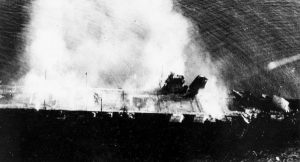 Allies, but on June 4, 1942, the Japanese aircraft carriers were attacked by dive-bomber aircraft from USS Enterprise, USS Yorktown, USS Hornet, and Midway Atoll. Hiryu was hit and severely crippled, and was set on fire. Japanese destroyer Makigumo torpedoed Hiryu on June 5, 1942 at 05:10 am, because she could not be salvaged. Only 39 men survived as after 4 hours, she sank with bodies of 389 men. Three other Japanese carriers were also sunk during the Battle of Midway. It was a battle that brought Japan’s first naval defeat since the Battle of Shimonoseki Straits in 1863. It was a great day for the Allies.
Allies, but on June 4, 1942, the Japanese aircraft carriers were attacked by dive-bomber aircraft from USS Enterprise, USS Yorktown, USS Hornet, and Midway Atoll. Hiryu was hit and severely crippled, and was set on fire. Japanese destroyer Makigumo torpedoed Hiryu on June 5, 1942 at 05:10 am, because she could not be salvaged. Only 39 men survived as after 4 hours, she sank with bodies of 389 men. Three other Japanese carriers were also sunk during the Battle of Midway. It was a battle that brought Japan’s first naval defeat since the Battle of Shimonoseki Straits in 1863. It was a great day for the Allies.
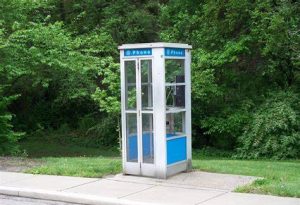 The current generation of kids probably have no idea what a phone booth is, besides maybe a place for Superman to change into his costume. From the time phones first became something that was provided to the public for a fee, phone booths became a common sight on city streets. Then in the 1950s, a new fad began. Much like the fad of stuffing as many people as possible into a car, people decided to stuff as many people as possible into a phone booth. My guess is that like most of these strange fads, this one too,
The current generation of kids probably have no idea what a phone booth is, besides maybe a place for Superman to change into his costume. From the time phones first became something that was provided to the public for a fee, phone booths became a common sight on city streets. Then in the 1950s, a new fad began. Much like the fad of stuffing as many people as possible into a car, people decided to stuff as many people as possible into a phone booth. My guess is that like most of these strange fads, this one too,  was practiced mostly by young people.
was practiced mostly by young people.
Phone booth stuffing first gained popularity outside the United States, but once it arrived stateside, in spring 1959, kids couldn’t help but join in. Basically, people would cram their bodies into the narrow spaces like sardines in a can. Some adopted other methods, such as stacking themselves horizontally. Just imagine being the guy on the bottom of the stack. All I can say is, “Hurry up, because I can’t breathe!!”
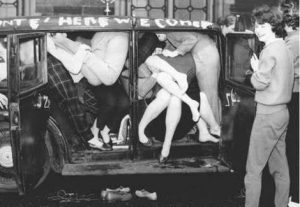 As with so many other crazy fad, phone booth stuffing became something to set a world record for. People began trying to outdo the prior record. The word record for phone-booth stuffing came in March 1959, when 25 people in South Africa piled into a booth. I can’t imagine how they could possibly fit 25 people in a phone booth, but while they were all in there, the phone rang. Of course, nobody answered the phone, because nobody could move enough to reach it. Sadly, the trend died by the end of 1959. Of course, that doesn’t mean that some of the other stuffing trends didn’t continue. I think people are still stuffing as many people as they can into a car. I just hope they don’t try to drive that way.
As with so many other crazy fad, phone booth stuffing became something to set a world record for. People began trying to outdo the prior record. The word record for phone-booth stuffing came in March 1959, when 25 people in South Africa piled into a booth. I can’t imagine how they could possibly fit 25 people in a phone booth, but while they were all in there, the phone rang. Of course, nobody answered the phone, because nobody could move enough to reach it. Sadly, the trend died by the end of 1959. Of course, that doesn’t mean that some of the other stuffing trends didn’t continue. I think people are still stuffing as many people as they can into a car. I just hope they don’t try to drive that way.
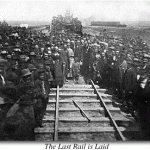 These days we don’t usually think much about trains as a form of transportation, but in 1869, they were the latest in modern travel. The United States is a large country, and it took months to travel across it with a horse drawn wagon. Travel was so time consuming, that most people could not take the necessary time off from their jobs and lives to go to visit family that had moved west, or those who stayed in the east. Enter the train.
These days we don’t usually think much about trains as a form of transportation, but in 1869, they were the latest in modern travel. The United States is a large country, and it took months to travel across it with a horse drawn wagon. Travel was so time consuming, that most people could not take the necessary time off from their jobs and lives to go to visit family that had moved west, or those who stayed in the east. Enter the train.
Trains could take people to far away destinations much faster, and cheaper…but there was still one problem…train tracks. The trains could only go as far as the tracks did, and the work of building tracks was a back breaking job. Nevertheless, 150 years ago, on this day, May 10, 1869, the presidents of the Union Pacific and Central Pacific railroads meet in Promontory, Utah. There they drove a ceremonial last spike into a rail line that connects their railroads. This made transcontinental railroad travel possible for the first time in United States history.

Now 150 years later, on of the trains that rode those rails in those days is back on the rails. The locomotives were called “Big Boys” and they certainly were. “It’s longer than two city buses, weighs more than a Boeing 747 fully loaded with passengers and can pull 16 Statues of Liberty over a mountain.” The refurbished Big Boy is the number 4014 steam locomotive that rolled out of a Union Pacific restoration shop in Cheyenne this past weekend for a big debut after five years of restoration. It then headed toward Utah as part of a yearlong tour to commemorate the Transcontinental Railroad’s 150th anniversary. If you have a chance, I would highly recommend that you get a copy of the schedule and plan to go see it. We are planning to, for sure.
 When we think of heroes during the Nazi years, we think mostly of men, but there were a few women who were real heroes too. One such woman, Sophia Magdalena Scholl, who was born on May 9, 1921, was a German student, who was also a serious anti-Nazi political activist. She was active within the White Rose non-violent resistance group in Nazi Germany. Scholl was the fourth of six children born to Magdalena (Müller) and liberal politician and ardent Nazi critic Robert Scholl. Her father was the mayor of her hometown of Forchtenberg am Kocher in the Free People’s State of Württemberg, at the time of her birth.
When we think of heroes during the Nazi years, we think mostly of men, but there were a few women who were real heroes too. One such woman, Sophia Magdalena Scholl, who was born on May 9, 1921, was a German student, who was also a serious anti-Nazi political activist. She was active within the White Rose non-violent resistance group in Nazi Germany. Scholl was the fourth of six children born to Magdalena (Müller) and liberal politician and ardent Nazi critic Robert Scholl. Her father was the mayor of her hometown of Forchtenberg am Kocher in the Free People’s State of Württemberg, at the time of her birth.
Scholl was brought up in the Lutheran church. She entered junior or grade school at the age of seven, and was considered an intelligent child who learned easily. Her childhood was a happy and carefree one. In 1930, the family moved to Ludwigsburg and then two years later to Ulm where her father had a business consulting office. These were definitely the best years of her life.
In 1932, after Scholl started attending a secondary school for girls, at the age of twelve, she chose to join the Bund Deutscher Mädel (League of German Girls), as did most of her classmates. It was as common as joining the girl scouts was in the United States. Her initial enthusiasm gradually gave way to criticism. She was aware of the dissenting political views of her father, friends, and some teachers. Even her own brother Hans, who once eagerly participated in the Hitler Youth program, became entirely disillusioned with the Nazi Party. Sophia was quickly learning of the horrors of Hitler and his Nazi regime. Political attitude had become an essential criterion in her choice of friends. The arrest of her brothers and friends in 1937 for participating in the German Youth Movement left a strong impression on her.
In 1943, with the Nazi movement in full swing, Sophia and her brother, Hans were at the University of Munich distributing anti-war leaflets when they were arrested and charged with high treason. Of course, handing out  anti-war leaflets in the United States would never be considered cause for a high treason conviction, but then Sophia and her brother did not live in the United States. In the People’s Court before Judge Roland Freisler on 22 February 1943, Scholl was recorded as saying these words, “Somebody, after all, had to make a start. What we wrote and said is also believed by many others. They just don’t dare express themselves as we did.” There was no testimony allowed for the defendants; this was their only defense. The brother and sister were subsequently convicted of the high treason charges, and as a result, were executed by guillotine on February 22, 1943. Since the 1970s, Scholl has been extensively commemorated for her anti-Nazi resistance work.
anti-war leaflets in the United States would never be considered cause for a high treason conviction, but then Sophia and her brother did not live in the United States. In the People’s Court before Judge Roland Freisler on 22 February 1943, Scholl was recorded as saying these words, “Somebody, after all, had to make a start. What we wrote and said is also believed by many others. They just don’t dare express themselves as we did.” There was no testimony allowed for the defendants; this was their only defense. The brother and sister were subsequently convicted of the high treason charges, and as a result, were executed by guillotine on February 22, 1943. Since the 1970s, Scholl has been extensively commemorated for her anti-Nazi resistance work.
 Everyone has heard the term, Uncle Sam used when referring to the United States government, but while the government and the people of the United States have “adopted” that term to mean the United States government, it was really never intended to be so. If you ask most people, the average older American would most likely point to the early 20th century and Sam’s frequent appearance on army recruitment posters. Nevertheless, the figure of Uncle Sam actually dates back much further than that. The actual figure of Uncle Sam, dates from the War of 1812. At that point, most American icons had been geographically specific, centering most often on the New England area. However, the War of 1812 sparked a renewed interest in national identity which had faded since the American Revolution.
Everyone has heard the term, Uncle Sam used when referring to the United States government, but while the government and the people of the United States have “adopted” that term to mean the United States government, it was really never intended to be so. If you ask most people, the average older American would most likely point to the early 20th century and Sam’s frequent appearance on army recruitment posters. Nevertheless, the figure of Uncle Sam actually dates back much further than that. The actual figure of Uncle Sam, dates from the War of 1812. At that point, most American icons had been geographically specific, centering most often on the New England area. However, the War of 1812 sparked a renewed interest in national identity which had faded since the American Revolution.
The term Uncle Sam was actually the nickname of a man named Samuel Wilson, who was a meat packer from Troy, New York. Sam supplied rations for the soldiers during the War of 1812. He had served in the American Revolution at the age of 15, and while he was born in Massachusetts, he relocated to the town of Troy, New York after the war. In Troy, Samuel and his brother, Ebenezer began the firm of E and S Wilson, a meat packing facility. Samuel was a man of great fairness, reliability, and honesty, who was devoted to his country. All of the local residents really liked Samuel, and they began calling him Uncle Sam.
During the War of 1812, the demand for meat supply for the troops was badly needed. Because he had been a soldier, Samuel had a soft spot in his heart for the soldiers. Secretary of War, William Eustis, made a contract with Elbert Anderson Jr of New York City to supply and issue all rations necessary for the United States forces in New York and New Jersey for one year. Anderson ran an advertisement on October 6, 1813 looking to fill the contract. The Wilson brothers bid for the contract and won. The contract was to fill 2,000 barrels of pork and 3,000 barrels of beef for one year. Their location on the Hudson River, made it ideal to receive the animals and to ship the product. As a security measure, the contractors were required to stamp their name and where the rations came from onto the food they were sending. Wilson’s packages bore the label “E.A. – US,” which stood for Elbert Anderson, the contractor, and the United States. When an individual in the meat packing facility asked what it stood for, a coworker joked and said it referred to Sam Wilson, Uncle Sam. A number of the soldiers were originally from Troy, and familiar with Samuel. When they saw the designation on the barrels, they, being acquainted with Sam Wilson and his nickname Uncle Sam, as well as the knowledge that Wilson was feeding the army, led them to the same conclusion. The local newspaper soon picked up on the story and Uncle Sam eventually gained widespread acceptance as the nickname for the U.S. federal government.
This is, of course, an endearing local story, and therefore, leaves some doubt as to whether it is the actual source of the term. Uncle Sam is mentioned previous to the War of 1812 in the popular song “Yankee Doodle,” which appeared in 1775. Nevertheless, the song doesn’t make it clear whether this reference is to Uncle Sam as a metaphor for the United States, or to an actual person named Sam. Another early reference to the term appeared in 1819, predating Wilson’s contract with the government. The connection between this local saying and the national legend is not easily traced. As early as 1830, there were inquiries into the origin of the term Uncle Sam. The connection between the popular cartoon figure and Samuel Wilson was reported in the New York Gazette on May 12, 1830. Whatever the source, Uncle Sam immediately became popular as a symbol of an ever-changing nation. His “likeness” appeared in drawings in various forms including resemblances to Brother Jonathan, a national personification and emblem of New England, and Abraham Lincoln, and others. In the late 1860s and 1870s, a political cartoonist named Thomas Nast began popularizing the image of Uncle Sam…building on the warm fuzzy feel of a beloved uncle. Nast continued to evolve the image, eventually giving Sam the white beard and stars-and-stripes suit that are associated with the character today.
However, it was a military recruiting poster, created in about 1917, that set the image of Uncle Sam was firmly set into American consciousness. The famous “I Want You” recruiting poster was created by James Montgomery Flagg and four million posters were printed between 1917 and 1918. The image was a really powerful one:  Uncle Sam’s striking features, expressive eyebrows, pointed finger, and direct address to the viewer made this drawing into an American icon. Throughout the years, Uncle Sam has appeared in advertising and on products ranging from cereal to coffee to car insurance. His likeness also continued to appear on military recruiting posters and in numerous political cartoons in newspapers. Finally, in September of 1961, the U.S. Congress recognized Samuel Wilson as “the progenitor of America’s national symbol of Uncle Sam.” Samuel Wilson died at age 88 in 1854, and was buried next to his wife Betsey Mann in the Oakwood Cemetery in Troy, New York. The town proudly calls itself “The Home of Uncle Sam.”
Uncle Sam’s striking features, expressive eyebrows, pointed finger, and direct address to the viewer made this drawing into an American icon. Throughout the years, Uncle Sam has appeared in advertising and on products ranging from cereal to coffee to car insurance. His likeness also continued to appear on military recruiting posters and in numerous political cartoons in newspapers. Finally, in September of 1961, the U.S. Congress recognized Samuel Wilson as “the progenitor of America’s national symbol of Uncle Sam.” Samuel Wilson died at age 88 in 1854, and was buried next to his wife Betsey Mann in the Oakwood Cemetery in Troy, New York. The town proudly calls itself “The Home of Uncle Sam.”
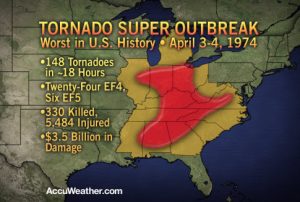 We all know that tornadoes are possible just about anywhere in the world…but in the United States, in an area well known as Tornado Alley, tornadoes are a common thing during tornado season, and sometimes outside of tornado season. Tornado Alley gets an average of more than 1,000 tornadoes a year, but on April 3, 1974, a super outbreak began. Over a less than 18 hour span, 148 tornadoes touched down across 13 states, with 21 in Indiana. The tornadoes hit North America from Georgia to Canada within 16 hours. At times there were as many as 15 separate tornadoes on the ground at one time. The Super Outbreak affected a total of 11 US states and Ontario in Canada. The Monticello tornado, which occurred during the weather event, tracked a whopping 121 miles, he longest tornado track in Indiana history! The 1974 tornado outbreak held the record as the largest outbreak in US history, killing 330 people…until the 2011 tornado outbreak, during which 360 tornadoes touched down killing 337 people.
We all know that tornadoes are possible just about anywhere in the world…but in the United States, in an area well known as Tornado Alley, tornadoes are a common thing during tornado season, and sometimes outside of tornado season. Tornado Alley gets an average of more than 1,000 tornadoes a year, but on April 3, 1974, a super outbreak began. Over a less than 18 hour span, 148 tornadoes touched down across 13 states, with 21 in Indiana. The tornadoes hit North America from Georgia to Canada within 16 hours. At times there were as many as 15 separate tornadoes on the ground at one time. The Super Outbreak affected a total of 11 US states and Ontario in Canada. The Monticello tornado, which occurred during the weather event, tracked a whopping 121 miles, he longest tornado track in Indiana history! The 1974 tornado outbreak held the record as the largest outbreak in US history, killing 330 people…until the 2011 tornado outbreak, during which 360 tornadoes touched down killing 337 people.
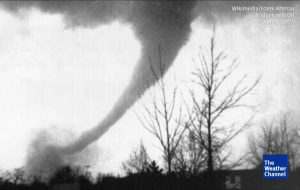
The outbreak began when a powerful low pressure system developed on April 1st, across the North American Interior Plains. As it moved into the Mississippi and Ohio Valley areas, a surge of very humid air intensified the storm further, and there were sharp temperature differences between both sides of the system. The National Weather Service began forecasting a severe weather outbreak on April 3, but no one expected the severity of the outbreak that actually occurred. Several F2 and F3 tornadoes struck portions of the Ohio Valley and the South in a separate, earlier outbreak on April 1 and 2, which included three killer tornadoes in Kentucky, Alabama, and Tennessee. The town of Campbellsburg, northeast of Louisville, was hard-hit in this earlier outbreak, with a large portion of the town destroyed by an F3. Between the two outbreaks, an additional tornado was reported in Indiana in the early morning hours of April 3, several hours before the official start of the outbreak. On Wednesday, April 3, severe weather watches already were issued from the morning from south of the Great Lakes, while in portions of the Upper Midwest, snow was reported, with heavy rain falling  across central Michigan and much of Ontario, which also had tornadoes.
across central Michigan and much of Ontario, which also had tornadoes.
Perhaps the most shocking fact from the 1974 outbreak was the amount of F4 and F5 tornadoes…with an incredible 30 (23 F4s and 7 F5s). The 1974 outbreak featured 30 violent tornadoes in less than one day when the national average is only about 7 per year. All seven of the F5 tornadoes occurred on the 3rd, and Alabama was the state that experienced the highest number of F5 tornadoes that day…three out of seven. The other F5 tornadoes occurred throughout Kentucky, Indiana, and Ohio. these super outbreaks are some of the most shocking weather phenomena ever.
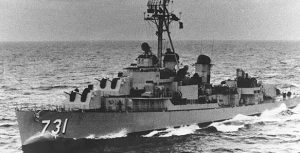 I was a born in the early days of the Vietnam War, so much of those early war years went unnoticed…by me anyway. The war official began on November 1, 1955, but there was much turmoil in the years leading up to the actual beginning of the war. It was an unpopular war, and probably the biggest news in the United States was the many protests against the war.
I was a born in the early days of the Vietnam War, so much of those early war years went unnoticed…by me anyway. The war official began on November 1, 1955, but there was much turmoil in the years leading up to the actual beginning of the war. It was an unpopular war, and probably the biggest news in the United States was the many protests against the war.
Nevertheless, there were some big operations that took place in the Vietnam War years. One such operation was Operation Plan (Oplan) 34A, and it was initiated on February 1, 1964, by the United States and the South Vietnamese. The plan called for raids by South Vietnamese commandos, operating under American orders, against North Vietnamese coastal and island installations. In this operation, the American forces were not directly involved in the actual raids, but United States Navy ships were on station to conduct electronic surveillance and monitor North Vietnamese defense responses under another program called Operation De Soto.
The Oplan 34A attacks played a major role in events that would eventually lead to what became known as the Gulf of Tonkin Incident. On August 2, 1964, North Vietnamese patrol boats, in response to an Oplan 34A attack by South Vietnamese gunboats against the North Vietnamese island of Hon Me, attacked the destroyer USS  Maddox. The Maddox was conducting a De Soto mission in the area. Then, just two days after the first attack, there was another incident, but that attack remains unclear. The Maddox, joined by destroyer USS C. Turner Joy, engaged what were thought to be more attacking North Vietnamese patrol boats.
Maddox. The Maddox was conducting a De Soto mission in the area. Then, just two days after the first attack, there was another incident, but that attack remains unclear. The Maddox, joined by destroyer USS C. Turner Joy, engaged what were thought to be more attacking North Vietnamese patrol boats.
There is some question as to whether or not the second attack actually happened, but the incident provided the rationale for retaliatory air attacks against the North Vietnamese and the subsequent Tonkin Gulf Resolution. That became the basis for the initial escalation of the war in Vietnam, and ultimately brought about the insertion of United States combat troops into the area.
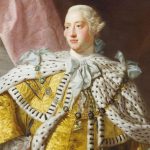 The American Revolution was a serious embarrassment to Britain, and especially to King George III. The king had to admit that things weren’t going well in the colonies…at least not where Britain was concerned. By now, the colonists had signed the Declaration of Independence that summer, and they were not going to be moved from achieving their goal to be a sovereign nation.
The American Revolution was a serious embarrassment to Britain, and especially to King George III. The king had to admit that things weren’t going well in the colonies…at least not where Britain was concerned. By now, the colonists had signed the Declaration of Independence that summer, and they were not going to be moved from achieving their goal to be a sovereign nation.
On this day, October 31, 1776, the king give a speech to the British Parliament, telling them about the signing of the United States Declaration of Independence and the revolutionary leaders who signed it, saying, “for daring and desperate is the spirit of those leaders, whose object has always been dominion and power, that they have now openly renounced all allegiance to the crown, and all political connection with this country.” I’m sure he felt that the colonists were rebels, who were not worth wasting time on by now, and he  hoped he could walk away from them without losing face any more than he already had. The British never intended for the United States to be anything more than the colones. The king went on to inform Parliament of the successful British victory over General George Washington and the Continental Army at the Battle of Long Island on August 27, 1776, but warned them that, “notwithstanding the fair prospect, it was necessary to prepare for another campaign.” Somehow, the king had the idea that there was still hope to keep the colonies.
hoped he could walk away from them without losing face any more than he already had. The British never intended for the United States to be anything more than the colones. The king went on to inform Parliament of the successful British victory over General George Washington and the Continental Army at the Battle of Long Island on August 27, 1776, but warned them that, “notwithstanding the fair prospect, it was necessary to prepare for another campaign.” Somehow, the king had the idea that there was still hope to keep the colonies.
Despite George III’s harsh words, General William Howe and his brother, Admiral Richard Howe, still hoped to convince the Americans to rejoin the British empire in the wake of the colonists’ humiliating defeat at the Battle of Long Island. They hoped to do 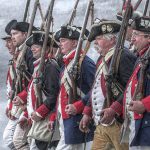 thing peacefully, but that was just not to be. The British could easily have prevented Washington’s retreat from Long Island and captured most of the Patriot officer corps, including the commander in chief. However, instead of forcing the former colonies into submission by executing Washington and his officers as traitors, the Howe brothers let them go with the hope of swaying Patriot opinion towards a return to the mother country. The Howe brothers’ attempts at negotiation failed, and the War for Independence dragged on for another four years, until the formal surrender of the British to the Americans on October 19, 1781, after the Battle of Yorktown. The freedom of the United States was not going to be taken from them…and that was a serious embarrassment to Britain.
thing peacefully, but that was just not to be. The British could easily have prevented Washington’s retreat from Long Island and captured most of the Patriot officer corps, including the commander in chief. However, instead of forcing the former colonies into submission by executing Washington and his officers as traitors, the Howe brothers let them go with the hope of swaying Patriot opinion towards a return to the mother country. The Howe brothers’ attempts at negotiation failed, and the War for Independence dragged on for another four years, until the formal surrender of the British to the Americans on October 19, 1781, after the Battle of Yorktown. The freedom of the United States was not going to be taken from them…and that was a serious embarrassment to Britain.
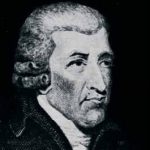
 Human beings have always had an interest in fire. Of course, fires have been around…forever, but people didn’t always have the ability to control them, or even get them started. Then 1826, John Walker was stirring a pot of chemicals when he noticed a dried lump had formed on the end of the mixing stick. Without thinking, John tried to scrape the dried glob. Suddenly, the stirring stick ignited. Immediately he knew he had found something amazing. So, he made lots more of his “friction lights” to sell at the local bookstore.
Human beings have always had an interest in fire. Of course, fires have been around…forever, but people didn’t always have the ability to control them, or even get them started. Then 1826, John Walker was stirring a pot of chemicals when he noticed a dried lump had formed on the end of the mixing stick. Without thinking, John tried to scrape the dried glob. Suddenly, the stirring stick ignited. Immediately he knew he had found something amazing. So, he made lots more of his “friction lights” to sell at the local bookstore.
The “friction lights” were three inches long and came neatly in a box with a piece of sandpaper. Walker wasn’t interested in patenting the idea, so Samuel Jones copied the matches and sold “Lucifers.” They were a little more practical than Walker’s friction lights. Lucifers were shorter and came in a smaller cardboard box for easy carrying. Too bad John Walker didn’t patent his product. Imagine how rich he would have become. Matches are still used in lots of places.
A Chinese book titled “Records of the Unworldly and the Strange,” by Tao Gu, makes reference to the earliest description of a match-like product. They were called “fire-inch sticks” and used sulfur to start the flame. Still, they were not strikeable, which makes me wonder how they worked exactly. French chemist Jean Chancel invented the first self-igniting match in 1805. Mr. Chancel’s method involved a wooden splint tipped with sugar and potassium chlorate that was carefully dipped into a small bottle of concentrated sulfuric acid. Chancel’s 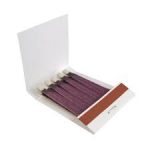
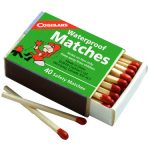 method was highly unpleasant and dangerous. The mix of chemicals produced a yellow smelly gas called chlorine dioxide, which explodes when it comes into contact with pretty much anything. Today, matches are made with non-poisonous red phosphorus, discovered by Johan Edvard Lundstrom. The Diamond Match Company was the first to sell “safety matches” in the United States, forfeiting their patent rights to allow all match companies to produce safe matches. Still, we can trace it all back to the accidental invention of John walker, pharmacist.
method was highly unpleasant and dangerous. The mix of chemicals produced a yellow smelly gas called chlorine dioxide, which explodes when it comes into contact with pretty much anything. Today, matches are made with non-poisonous red phosphorus, discovered by Johan Edvard Lundstrom. The Diamond Match Company was the first to sell “safety matches” in the United States, forfeiting their patent rights to allow all match companies to produce safe matches. Still, we can trace it all back to the accidental invention of John walker, pharmacist.
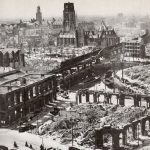 After World War II, most of Europe was in a big mess, whether it was the land,the cities and towns, or the government. There were scores of dead people around, countries and borders were torn apart, most of Europe had been “ground into a very civilized kind of pudding…and the USSR was knocking on the door to come and raid the fridge…so to speak.” Russia would have loved to sneak in and take over when they were at their most vulnerable. The people looked to the United States to figure out away to keep them safe, but not to occupy their countries, per se. That is a rather tall order, but one that the United States took seriously.
After World War II, most of Europe was in a big mess, whether it was the land,the cities and towns, or the government. There were scores of dead people around, countries and borders were torn apart, most of Europe had been “ground into a very civilized kind of pudding…and the USSR was knocking on the door to come and raid the fridge…so to speak.” Russia would have loved to sneak in and take over when they were at their most vulnerable. The people looked to the United States to figure out away to keep them safe, but not to occupy their countries, per se. That is a rather tall order, but one that the United States took seriously.
So the United States came up with Operation Gladio. Basically, they installed a secret military that would unofficially operate all across Europe. The secret military would have one and only one goal…combating communism. Little is known about this secret military, even today, because it wouldn’t be a very good secret army if we knew all about them. So, facts are pretty limited, but it’s not some crazy theory either. Their existence has been confirmed, and the network has been associated with such high-stakes super-evil events, as an attempted pope assassination, large scale bombings, and kidnappings of several high-level government officials. They were willing to do anything to fight communism…murder, extortion, even seemingly becoming communists, if that’s what it took. It turns out that the Italian branch was a particularly active group. An entirely different president of Italy, Francesco Cossiga, was involved in this ominous anti-communism secret society. The reason we don’t know more about them, even years after the end of the Cold War, is simple: crazy, crazy murders. Their secrets will follow them to the grave.
Then a new Italian president was elected. President Aldo Moro, wanted to allow communists to run for office.The still operating Gladio could not let this happen. He was suddenly kidnapped and eventually executed.  His body was found in the trunk of a car parked next to an ancient gladiatorial site. A warning to others…more than probably!! A “gladio” is an ancient Roman short sword, used in arena combat. A former colonel of Gladio operations in Switzerland decided to write a letter to the government stating that he was ready to “reveal the whole truth.” Again, Operation Gladio took action. The Gladio colonel was found dead in his home a month later. He was stabbed to death with his own bayonet. There were a series of mysterious characters written on his chest that couldn’t be deciphered. Of course, that’s not concrete evidence of Gladio’s direct involvement in these events, but these are just two brutal, worrying events that spin a web of mystery and fear that keeps further investigations from being opened. Sometimes, it’s best to let sleeping dogs lie.
His body was found in the trunk of a car parked next to an ancient gladiatorial site. A warning to others…more than probably!! A “gladio” is an ancient Roman short sword, used in arena combat. A former colonel of Gladio operations in Switzerland decided to write a letter to the government stating that he was ready to “reveal the whole truth.” Again, Operation Gladio took action. The Gladio colonel was found dead in his home a month later. He was stabbed to death with his own bayonet. There were a series of mysterious characters written on his chest that couldn’t be deciphered. Of course, that’s not concrete evidence of Gladio’s direct involvement in these events, but these are just two brutal, worrying events that spin a web of mystery and fear that keeps further investigations from being opened. Sometimes, it’s best to let sleeping dogs lie.

